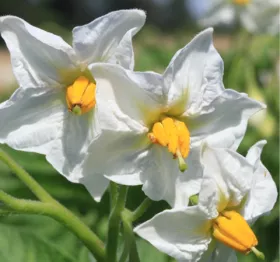Northern Plains Fresh Market Potato Cultivar/Selection Trial Results for 2016
(A1834 Reviewed March 2022)Potato growers continually are looking for the next potato cultivar that provides high yield and good quality, and can be produced sustainably. Determining what new potato cultivars or selections are best suited for production in a given area is essential. For this reason, we have tested newly developed potato cultivars and advanced selections in central Minnesota to determine adaptation and how they respond to local environmental conditions. Studies during multiple years will help determine the best cultivars when grown in various environments.
Asunta Thompson, Potato Breeder, North Dakota State University

Potato growers continually are looking for the next potato cultivar that provides high yield and good quality, and can be produced sustainably.
In response to these needs, potato breeders develop new potato cultivars possessing desirable genetic traits. These traits may include increased yield potential; resistance to diseases; better tuber size profile; improved skin color, skin fitness and finish; fewer blemishes; better storability; greater drought tolerance; or enhanced nutrient-use efficiency.
The development of new cultivars can take 10 to 15 years. While in development, potato genotypes are referred to as selections because they are selected from a potato breeding program (these typically are numbered). Cultivars are potato selections that have been named.
With such a long time commitment, determining what new potato cultivars or selections are best suited for production in a given area is essential.
For this reason, we have tested newly developed potato cultivars and advanced selections in central Minnesota to determine adaptation and how they respond to local environmental conditions. Studies during multiple years will help determine the best cultivars when grown in various environments.
Potato cultivars or selections included in this report were selected from recently released cultivars or from advancing selections with release potential (numbered lines progressing through the trial process), or cultivars that are new to the U.S. Standard potato cultivars used by growers, including Red Norland and Satina, served as checks.
In 2016, the variety trial was conducted to identify traits of various cultivars and advanced selections at Big Lake, Minn. Twenty-one red-skinned cultivars and six yellow-skinned cultivars evaluated.
Plots were established in a commercial, irrigated potato field utilizing common potato production practices. A randomized complete block design was utilized with four replicates. Seed tubers were hand cut to 2-ounce seed pieces and suberized for approximately five to 10 days at 55 F and 95 percent relative humidity prior to planting.
Tubers were planted on April 21, 2016, at a 9-inch within-row spacing; rows were spaced 36 inches apart. Plots were single rows 25 feet in length, with 33 seed pieces planted per plot. Plots were harvested on Aug. 16, and the potatoes were stored at 55 F until grading.
The tuber size profile distribution was determined by sorting potatoes into C size (less than 1.9 inches), B size (1.9 to 2.25 inches), A size (2.25 to 3.5 inches) and Chef size (greater than 3.5 inches).
The agronomic data presented in Tables 1 and 2 were statistically analyzed. These analyses allow the reader to ascertain, at a predetermined level of confidence, if the differences observed among cultivars/selections are reliable, or if they might be due to error inherent in the experimental process.
The LSD (least significant difference) values beneath the columns apply only to the numbers in the column in which they appear. If the difference between two cultivars/selections exceeds the LSD value at 0.05 or 0.10, it means that with 95 or 90 percent confidence, respectively, the higher-yielding cultivar/selection has a significant yield advantage. When the difference between two cultivars/selections is less than the LSD value, no significant difference was found between the two under these growing conditions.
The CV stands for coefficient of variation and is expressed as a percentage. The CV is a measure of variability in the trial. Large CVs mean a large amount of variation that could not be attributed to differences in the cultivars/selections.
The data provided does not indicate endorsement or approval by the authors, or NDSU Extension or University of Minnesota Extension. Reproduction of the tables is permissible if presented with all the same information found in this publication (meaning no portion is deleted and the order of the data is not rearranged).
The authors acknowledge the contribution of cultivars and advanced selections for this work from the U.S. Department of Agriculture/Agricultural Research Service, Colorado State University, North Dakota State University, University of Minnesota and University of Wisconsin.
Table 1. Agronomic performance and graded yield of red-skinned potato cultivars/selections, Big Lake, Minn., 2016.
|
Cultivar/Selection |
Stand1 |
Stems/plant2 |
Tuber |
Vine vigor3 |
C4 |
B |
A |
Chef |
Total yield |
| Number | Number | Number | cwt/a | cwt/a | cwt/a | cwt/a | cwt/a | ||
|
AND00272-1R |
30 |
3.7 |
259 |
2.7 |
7 |
106 |
274 |
7 |
394 |
|
CO00277-2R |
27 |
4.0 |
374 |
4.0 |
71 |
154 |
163 |
0 |
389 |
|
CO98012-5R |
28 |
2.4 |
293 |
4.0 |
12 |
166 |
133 |
1 |
314 |
|
CO99076-6R |
26 |
2.2 |
247 |
2.3 |
6 |
125 |
183 |
7 |
322 |
|
Crimson Red |
26 |
2.1 |
185 |
2.7 |
1 |
73 |
268 |
29 |
371 |
|
Dakota Ruby |
29 |
2.6 |
270 |
2.3 |
22 |
127 |
178 |
6 |
334 |
|
Dark Red Norland |
23 |
2.2 |
215 |
2.7 |
2 |
84 |
275 |
19 |
380 |
|
MN10002PLWR-06R |
23 |
3.8 |
201 |
1.3 |
9 |
779 |
227 |
5 |
319 |
|
MN13097PLWR-02R |
26 |
2.8 |
277 |
1.0 |
22 |
142 |
155 |
6 |
325 |
|
ND7982-1R |
28 |
4.8 |
358 |
3.0 |
51 |
171 |
89 |
0 |
311 |
|
ND4659-5R |
29 |
2.5 |
300 |
2.0 |
9 |
150 |
223 |
5 |
387 |
|
ND6002-1R |
30 |
2.3 |
268 |
2.0 |
9 |
115 |
248 |
4 |
376 |
|
ND7132-1R |
29 |
1.8 |
251 |
3.0 |
8 |
118 |
226 |
7 |
359 |
|
NDA7985-1R |
27 |
2.4 |
246 |
3.0 |
11 |
95 |
267 |
9 |
382 |
|
NDCO81655-1R |
30 |
3.4 |
386 |
3.0 |
57 |
192 |
99 |
0 |
348 |
|
Red Endeavor |
26 |
3.6 |
293 |
4.3 |
5 |
179 |
190 |
3 |
377 |
|
Red Norland |
31 |
2.9 |
224 |
5.0 |
2 |
54 |
381 |
29 |
466 |
|
Runestone Gold |
26 |
3.5 |
272 |
4.0 |
6 |
128 |
261 |
5 |
399 |
|
Sangre |
26 |
1.6 |
238 |
1.0 |
24 |
109 |
151 |
2 |
285 |
|
W8890-1R |
27 |
4.1 |
326 |
4.3 |
82 |
157 |
213 |
4 |
456 |
|
Column mean |
27 |
3.0 |
274 |
2.9 |
20 |
129 |
209 |
7 |
366 |
|
CV % |
10 |
12 |
25 |
20 |
154 |
33 |
40 |
123 |
22 |
|
LSD 0.05 |
4 |
0.5 |
93 |
0.8 |
42 |
58 |
115 |
12 |
112 |
|
LSD 0.10 |
4 |
0.6 |
111 |
1.0 |
51 |
70 |
138 |
15 |
134 |
1Stand count was taken on June 2 (six weeks after planting) by counting every emerged plant.
2Stems per plant were counted on all plants on June 22 (eight weeks after planting) and are shown as the average number of stems per plant.
3Vigor evaluation was completed on June 2 (six weeks after planting). Rating compared with Red Norland being a 5. A rating of 1 indicated least vigor and 5 greatest vigor.
4Potatoes were sorted on a Kerian Speed sizer as C = less than 1.9, B = 1.9-2.25, A = 2.25-3.5 and Chef = greater than 3.5 inches.
Table 2. Agronomic performance and graded yield of yellow-skinned potato cultivars/selections, Big Lake, Minn., 2016.
|
Cultivar/Selection |
Stand1 |
Stems/plant2 |
Tuber |
Vine vigor3 |
C4 |
B |
A |
Chef |
Total yield |
|
Number |
Number |
Number |
cwt/a | cwt/a | cwt/a | cwt/a | cwt/a | ||
|
A05182-7Y |
29 |
3.0 |
415 |
4.8 |
52 |
188 |
163 |
3 |
405 |
|
CO05037-3W/Y |
28 |
4.6 |
363 |
4.3 |
23 |
219 |
143 |
0 |
384 |
|
MN02586 |
27 |
3.7 |
361 |
5.0 |
26 |
177 |
160 |
0 |
363 |
|
MN13041PLWR-03 |
26 |
3.6 |
205 |
3.5 |
11 |
110 |
116 |
2 |
239 |
|
NDA081451CB-1CY |
27 |
4.5 |
426 |
4.8 |
60 |
225 |
66 |
0 |
351 |
|
Satina |
27 |
3.0 |
317 |
5.0 |
12 |
135 |
290 |
1 |
437 |
|
Mean |
27 |
3.7 |
348 |
4.5 |
31 |
176 |
156 |
1 |
363 |
|
CV % |
10 |
18.7 |
13 |
9.4 |
21 |
29 |
13 |
239 |
13 |
|
LSD 0.05 |
ns5 |
0.9 |
56 |
0.5 |
23 |
46 |
55 |
ns |
59 |
|
LSD 0.10 |
ns |
1 |
67 |
0.6 |
27 |
55 |
67 |
ns |
71 |
1Stand count was taken on June 2 (six weeks after planting) by counting every emerged plant.
2Stems per plant were counted on all plants on June 2 (six weeks after planting) and are shown as the average number of stems per plant.
3Vigor evaluation was completed on June 22 (nine weeks after planting). Rating compared with Satina being a 5. A rating of 1 indicated least vigor and 5 greatest vigor.
4Potatoes were sorted on a Kerian Speed sizer as C = less than 1.9, B = 1.9-2.25, A = 2.25-3.5 and Chef = greater than 3.5 inches.
5ns indicates the data was not significant.
NDSU Extension does not endorse commercial products or companies even though reference may be made to tradenames, trademarks or service names. NDSU encourages you to use and share this content, but please do so under the conditions of our Creative Commons license. You may copy, distribute, transmit and adapt this work as long as you give full attribution, don’t use the work for commercial purposes and share your resulting work similarly. For more information, visit www.ag.ndsu.edu/agcomm/creative-commons.
For more information on this and other topics, see www.ndsu.edu/extension
County commissions, North Dakota State University and U.S. Department of Agriculture cooperating. NDSU does not discriminate in its programs and activities on the basis of age, color, gender expression/identity, genetic information, marital status, national origin, participation in lawful off-campus activity, physical or mental disability, pregnancy, public assistance status, race, religion, sex, sexual orientation, spousal relationship to current employee, or veteran status, as applicable. Direct inquiries to Vice Provost for Title IX/ADA Coordinator, Old Main 201, NDSU Main Campus, 701-231-7708, ndsu.eoaa@ndsu.edu. This publication will be made available in alternative formats for people with disabilities upon request, 701-231-7881. 150-2-17; web-3-22

